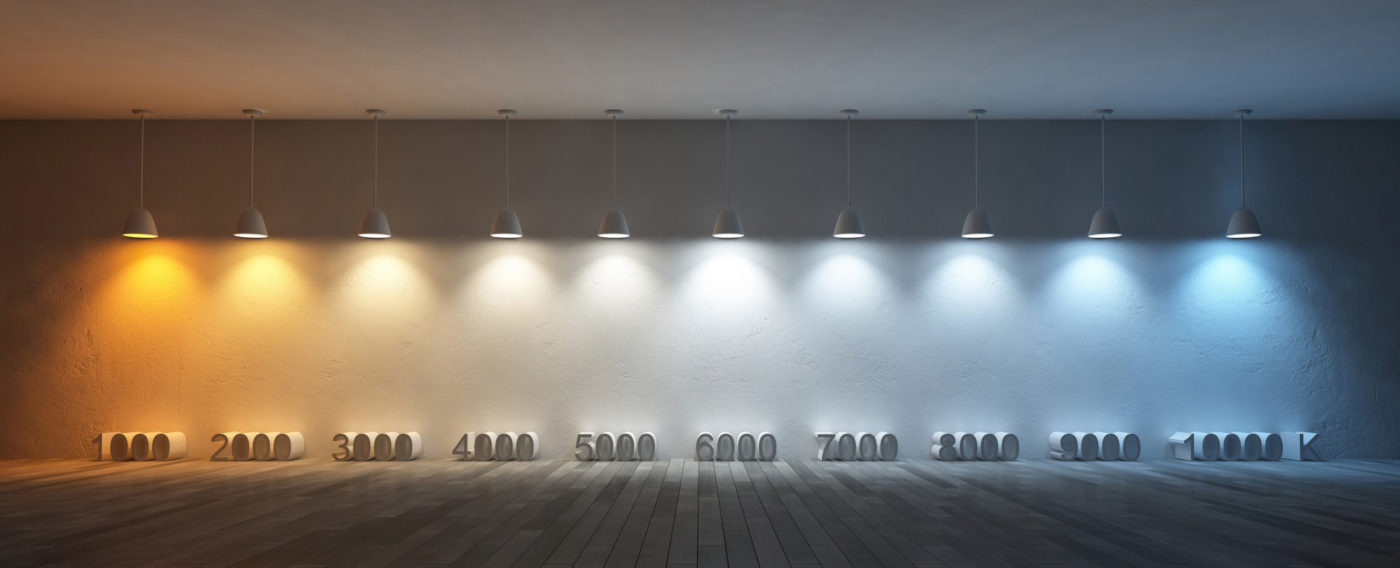WHAT IS COLOUR TEMPERATURE?
Colour temperature is measured in degrees Kelvin (K). The colour temperature of a lamp (bulb/LED) describes how the light appears when the human eye looks directly at the illuminated bulb.
HOW IS COLOUR TEMPERATURE MEASURED?
Colour temperature is measured by a unit called the Kelvin (K). The Kelvin thermodynamic temperature scale is defined so that absolute zero is 0 kelvins (K). (Note: The Celsius and Fahrenheit scales are defined so that absolute zero is −273.15 °C or −459.67 °F). Imagine heating a bar of steel and observing the colour of the bar at increasing temperatures. At some point the bar will appear to glow a dull red. As heat is added, the dull red turns to yellow, then to white, then to bluish white, finally to blue.
HOW COLOUR TEMPERATURE WORKS
A light bulb that produces light perceived as yellowish white will have a colour temperature of around 2700K. As the colour temperature increases to 3000K – 3500K, the colour of the light appears less yellow and more white. When the colour temperature is 5000K or higher the light produced appears bluish white. The colour temperature of daylight varies, but is often in the 5000K to 7000K range.
2000-2500K – VERY WARM LIGHT
When the desired lighting effect is “very warm”, use light sources in the 2000K – 2500K range. These can be hard to find at the required strength to backlight a lithophane, so you’re probably better going for a less warm light or combining very warm and warm together to achieve the required “look” you want.
2700-2800K – WARM LIGHT
When the desired lighting effect is “warm”, use light sources in the 2700K – 2800K range. Most common incandescent light bulbs will produce light in this colour temperature range. An exception is the incandescent light bulb with a neodymium coating. The neodymium filters out the yellow and red wavelengths of the visible spectrum leaving predominantly blue wavelengths. So even though neodymium light bulbs have a 2800K colour temperature, the light they produce appears to be bluer – similar to daylight and to other light bulbs that product light with colour temperatures in the 5000K or higher range.
3500-4000K — NEUTRAL BRIGHT LIGHT
When the desired effect is neutral or bright white, use light sources in the 3000K – 3500K range. For a slightly bluer, “cooler” effect use 4000K.
5000-6500K — SIMULATE DAYLIGHT
Daylight colour temperature at noon is 5600K, but sunlight colour temperature can vary widely based on time of day and weather conditions. To give the perception of daylight (bluish white light), use light sources with a colour temperature of 5000K or higher.
OTHER INFORMATION
Colour temperature designations of light bulbs and LED lights can be confusing. Sometimes you’ll see subjective terms such as “warm white” or “cool white.” Other times, the quantitative Kelvin temperature number will be used: 2700K (warm white), 4100K (cool white).
Here are some approximate reference points:-
Candle light: 1800K (warm yellow)
Standard 60W incandescent light bulb: 2700K (warm white),
Portrait photo studio light: 3200K (neutral white)
Fluorescent lights (classroom/office style): 4100K (cool white)
Daylight (with a very slight overcast sky): 6500K (bluish, white light).
Most incandescent and halogen bulbs are in the Kelvin range 2700K-3000K. Fluorescent, metal halide and LED bulbs can be purchased with colour temperature options from 2700K to 6500K. You can find LED lights in the 2000-2600K range, but in general they are expensive and the illumination is quite weak from them.



